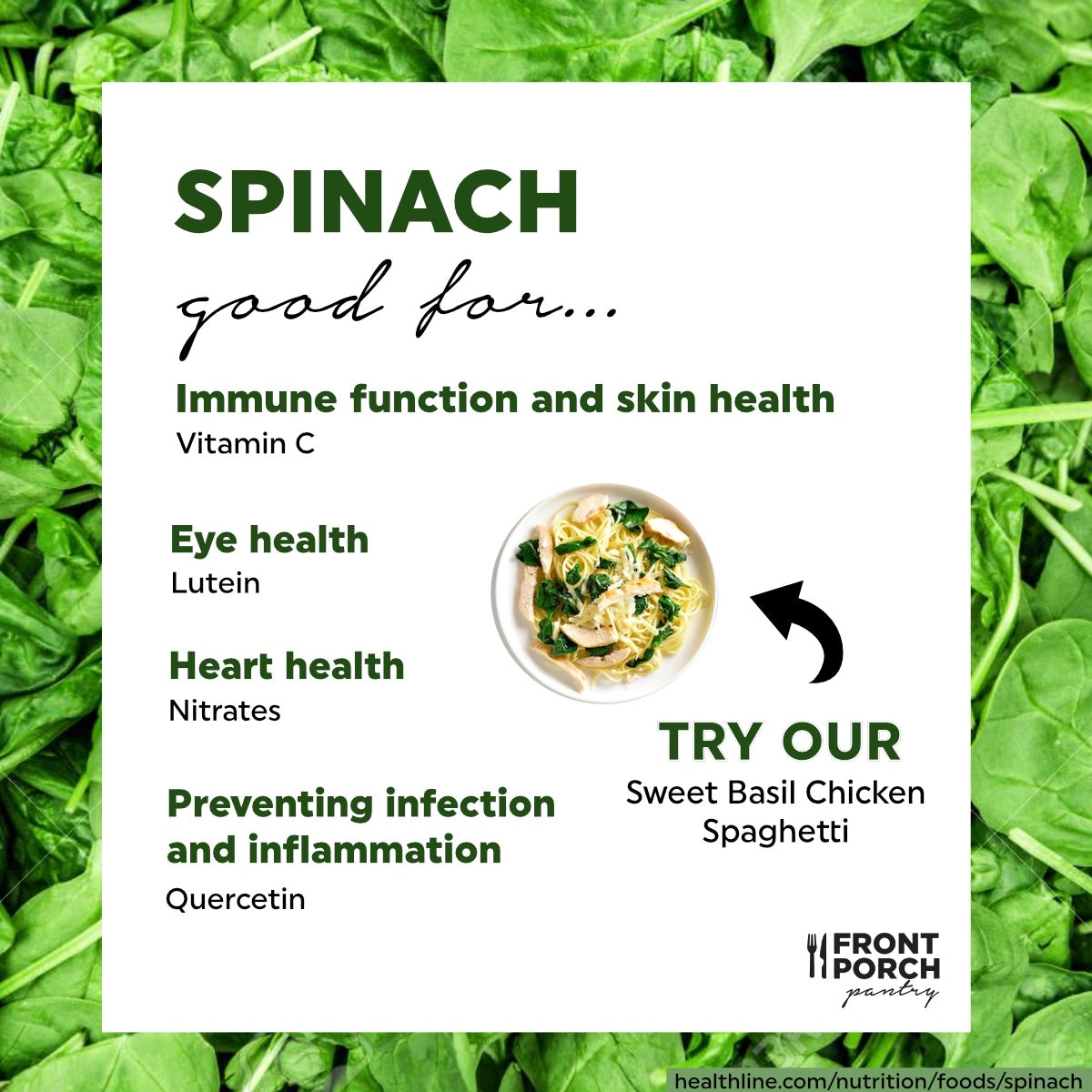Your Cart is Empty

We all know Popeye the Sailor Man, a cartoon character who, with just a bite of spinach, becomes as fast as a rocket and as tough as steel. But have you ever wondered what makes Popeye love this vegetable so much? Unlike Popeye, spinach will not make an ordinary human like us invincible. But that doesn't take away from the fact that spinach is still one of the most nutritious and delicious vegetables out there.
Originally from ancient Persia, spinach was introduced to India and China in 647 AD, where it was named the "Persian vegetable." After that, it gained popularity in France and England in the 14th century, arriving with the first settlers to America. A fun historical fact is that in the medieval days, artists used to extract the pigment of this vegetable to use it as paint. Isn't that crazy?
Like all vegetables, spinach has variations. The two main types of spinach are Savoy and Flat or Smooth. The first is the one commonly sold in the United States, characterized by dark, crinkly leaves. While the second is, as its name says, flat. This leafy green vegetable belongs to the Amaranthaceae family and is considered an excellent source of antioxidants and vital nutrients. In fact, half a cup of spinach provides us with one of the five servings of the daily recommended vegetable consumption. That is a lot of nutrition!
Vitamin C. One of the most predominant vitamins in spinach is vitamin C. This rich vitamin is an antioxidant that promotes skin health and immune function. In addition, it helps protect our cells against the effect of free radicals, which are related to some types of cancer and heart disease. Like other vitamins, vitamin C is not produced in our body. We must obtain it from the food we eat, with spinach being one of the most recommended sources.
Vitamin A. Continuing with the list of vitamins, we have vitamin A. Although spinach itself does not contain vitamin A, this vegetable is high in carotenoids, which our body transforms into vitamin A. How does this vitamin benefit us, you may wonder? Vitamin A plays a significant role in immune system function, eye health, and growth.
Vitamin K1. Vitamin K1 is responsible for creating proteins needed for blood clotting and supports the building of bones. One cup of raw spinach contains more than our minimum daily intake of vitamin K1.
Vitamin B9. The natural form of vitamin B9 is known as folate. Spinach has one of the highest natural concentrations of folate found in any food. Folate or vitamin B9 helps in the formation of DNA and RNA and the production of healthy red blood cells. It is also essential in periods of rapid growth, which is why it is so important during pregnancy.
Calcium. Spinach also contains calcium. This mineral is typically associated with bones and teeth. But it is also vital for the heart and muscles and is one of the signaling molecules of the nervous system.
Iron. This mineral is necessary for producing hemoglobin, the protein in red blood cells responsible for carrying oxygen from our lungs to all body tissues.
Spinach isn't just a good source of vitamins and minerals; it also has beneficial plant compounds.
Nitrates. They may play a key role in having a healthy cardiovascular system. Also, nitrates increase the efficiency of the mitochondria. In other words, nitrates help us do more work with the same amount of oxygen. This is why spinach and similar vegetables are so important in the diet of athletes and strongmen like Popeye the Sailor Man.
Quercetin.Quercetin is a plant pigment found in many vegetables and fruits. It has anti-inflammatory and antioxidant effects that help control blood sugar, prevent heart disease, kill cancer cells, and reduce swelling.
Lutein and Zeaxanthin. They both are carotenoids found in our eyes. They help protect our eyes from sunlight damage by functioning as a light filter. Overall, Lutein and Zeaxanthin improve eye health. Just one cup of spinach can provide most of our recommended daily intake of these two compounds.
Kaempferol. Kaempferol helps defend our body against free radicals and reduces the risk of chronic diseases like cancer.
Spinach is excellent at fighting oxidative stress caused by an excess of free radicals. Consequently, this vegetable helps prevent accelerated aging and the risk of suffering from diabetes or cancer. As mentioned, Lutein and Zeaxanthin help with the health of our eyes. But it is much more than just protection against the sun's rays. Studies have found that these compounds prevent cataracts and macular degeneration, thereby preventing blindness.
Experts consider spinach to be a "power food." We don't need to eat pounds and pounds of spinach like Popeye; adding one or two cups of spinach to our daily diet is enough to make a difference. At Front Porch Pantry, we not only care about delivering delicious and hearty meals straight to your front porch, but we also make sure to use the freshest ingredients. Spinach is one of those ingredients that never fails to make our meals taste just like the ones mom used to make at home!
Quality, fresh & healthy ingredients combined with excellent service is what sets us apart from other meal services. Our goal is to service customers that need and crave delicious, healthy, and convenient meals and to keep our customers coming back for more.
Sources:
https://blog.aghires.com/15-ag-facts-about-spinach/
https://www.healthline.com/nutrition/foods/spinach
https://en.wikipedia.org/wiki/Spinach
https://www.healthline.com/nutrition/vitamin-k1-vs-k2#TOC_TITLE_HDR_8
https://www.hsph.harvard.edu/nutritionsource/folic-acid/
https://www.medicalnewstoday.com/articles/287228#benefits
https://www.mayoclinic.org/drugs-supplements-vitamin-c/art-20363932
https://www.sciencedirect.com/science/article/pii/B9780123746283000256
https://pubmed.ncbi.nlm.nih.gov/10693912/
https://pubmed.ncbi.nlm.nih.gov/12626691/
https://pubmed.ncbi.nlm.nih.gov/23497863/
https://pubmed.ncbi.nlm.nih.gov/21102328/
https://pubmed.ncbi.nlm.nih.gov/22019438/
https://www.sciencedirect.com/science/article/abs/pii/S0753332215000773
https://pubmed.ncbi.nlm.nih.gov/18417116/
https://pubmed.ncbi.nlm.nih.gov/26022682/
https://pubmed.ncbi.nlm.nih.gov/7933422/
https://pubmed.ncbi.nlm.nih.gov/16936087/
Comments will be approved before showing up.